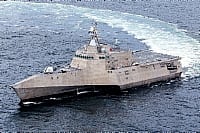The House Appropriations Committee criticized the Navy for cutting a destroyer from the previously planned fiscal year 2022 budget request and its plan to decommission additional littoral combat ships (LCSs) in the newly released defense appropriations bill report.
The report, released Monday, said the committee “is dismayed by the Navy’s decision to remove one DDG–51 Flight III Destroyer from the planned fiscal year 2022 budget request.”
The FY ‘22 budget request previously received a negative reaction from the congressional defense committees after
seeking $2 billion for only one Arleigh Burke-class (DDG-51) destroyer (Defense Daily, May 28).
The destroyers are built by General Dynamics’ [GD] Bath Iron Works in Maine and Huntington Ingalls Industries’ [HII] Ingalls Shipbuilding in Pascagoula, Miss. In 2018, the Navy awarded HII a $5.1 billion contract for six Flight III variant destroyers and GD a $3.9 billion contract for four more destroyers, under plans to build two per year (Defense Daily, Sept. 28, 2018).
The report, put together by the House Appropriations Committee’s defense panel, noted this is the second year in a row the Navy’s budget request took out a major ship from the previous plan “rather than make difficult funding decisions in a fiscally constrained environment.”
The Navy’s FY ‘21 budget request sought funds for only one more Virginia-class attack submarine rather than the previously planned two and the service listed the second submarine on its unfunded requirements list. However, the Trump administration reversed itself and later asked Congress to fund the second submarine (Defense Daily, Nov. 30, 2020).
In that case the Navy first requested $4.2 billion for one submarine but Congress enacted $6.8 billion for two vessels. Congress also passed the FY ‘21 defense authorization act which included funds for the second submarine (Defense Daily, Dec. 11, 2020).
“This represents a troubling trend of underfunding ship acquisition programs and then requesting the removed ship as the highest priority on the unfunded priority list,” the report continued.
The Navy named the second destroyer as its top unfunded priority in an annual list sent to Congress, at a value of an additional $1.66 billion (Defense Daily, June 2).
Several service officials said budget constraints led the Navy to cut the destroyer.

Earlier this month, Rear Adm. John Gumbleton, deputy assistant secretary of the Navy for budget said the Navy judged the $33 million penalty incurred by cancelling the promised final multiyear procurement contract vessel as worth it to save a larger amount to focus on funding the Columbia-class ballistic missile submarine adequately along with current readiness and investments in future capabilities (Defense Daily. July 2).
In June, Acting Secretary of the Navy Thomas Harker told the Senate Appropriations Defense subcommittee the destroyer issue was the “hardest decision we made and we would love to have been able to include it.” Chief of Naval Operations Adm. Mike Gilday added it was “absolutely an affordability issue, we fought for that hull right to the bitter end” (Defense Daily, June 25).
In this bill report, the committee argued breaking the multi-year procurement contract “adversely impacts the already fragile domestic shipbuilding industrial base.”
As a result, the committee recommends reducing multiple other unspecified Navy programs to provide $1.5 billion in funding for the second DDG-51 destroyer.
In the report the committee also noted the current multi-year contract for destroyers ends in fiscal year 2022 and the Navy already delayed the detail design and construction schedule of the planned large surface combatant to succeed the DDG-51 until at least 2026.
Therefore, it recommended a follow-on multi-year procurement contract starting in FY ‘23 as a potential “prudent plan to ensure a smooth shipbuilding manufacturing and design industrial base transition from the DDG–51 to the follow-on large surface combatant.”
Indeed, during that June hearing Harker told the Senate panel the Navy plans to sign another multi-year procurement contract for destroyers that goes from FY ‘23 to ‘27.
Separately, the bill recommends limiting the Navy’s planned additional LCS divestments to only decommissioning the USS Coronado (LCS-4). The Navy’s FY ‘22 budget request sought to save $186 million by divesting the USS Fort Worth (LCS-3), Coronado, Detroit (LCS-7) and Little Rock (LCS-9).
Budget documents argued LCS-3 and 4 are primarily test platforms and decommissioning them would let the Navy avoid the cost of upgrading the ships to the common configuration and capability as the rest of the fleet while redirecting funds to higher capability platforms and investments. The service also argued the vessels do not have mission packages assigned to them and the current procurement program is not planning to add them.
Last year, Congress granted the Navy permission to decommission the first two LCSs, USS Freedom (LCS-1) and USS Independence (LCS-2).
The Navy argued it should also be allowed to retire LCS-7 and 9 because they experienced major propulsion train casualties with the combining gear issue and “will incur significant associated repair costs.”
Indeed, in January the Navy stopped accepting the odd-numbered Freedom-variant LCSs due to a material defect with the combining gear until the design fix is in production, testing is complete, and the fix is installed on the ships (Defense Daily, Jan. 22).
However, the House Appropriations Committee was not convinced by these arguments.
“The Committee is disappointed that the Navy has planned to decommission two ships, the USS Detroit and the USS Little Rock, that are five and four years old, respectively. The Committee believes this is a misuse of taxpayer funds,” the report said.
The bill would instead direct the Secretary of the Navy to provide the congressional defense committees with a report within 60 days of the bill’s enactment on specific missions and plans for the USS Fort Worth, the USS Detroit, and the USS Little Rock in the fiscal year 2023 budget request.
The House Appropriations Committee will markup the FY ’22 Defense Department budget request on Tuesday.